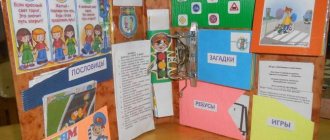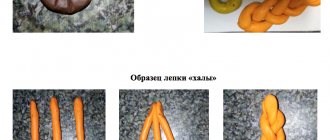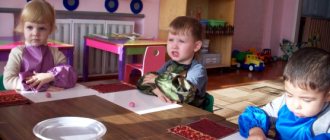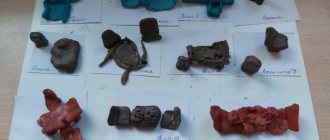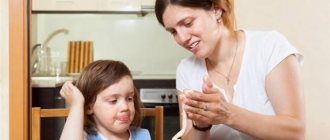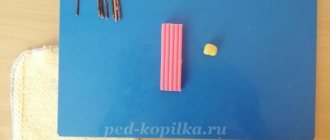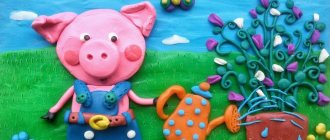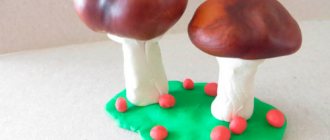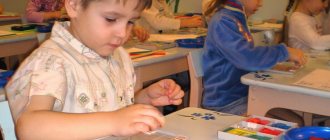Modeling is a great way to develop fine motor skills, perseverance, perception, imagination and intelligence. It enriches the baby’s sensory experience and helps in dealing with stress and aggression.
Therefore, it is important to regularly engage in this useful creative activity from an early age.
In this article I will talk about how to sculpt with children aged 1–3 years, about materials, techniques and techniques. You can also download templates for modeling lessons with your child.
How to sculpt with kids
Some useful tips for sculpting with kids:
- Start as early as possible. Is your baby almost a year old? - it's time to introduce him to dough or soft mass for modeling. Let him just pinch off pieces or make dents. This is very useful for the baby. In any case, much more useful than learning to “read from the cradle.”
- The younger the child, the softer the material for modeling should be. Start with salt dough or a special modeling compound such as Play Doh.
- Plasticine allows you to do things that cannot be done with dough or mass. Therefore, do not delay your acquaintance with this material. But for starters, also choose the softest one possible, for example, Beam Krokha (Labyrinth, Ozone, My-shop).
- At first, classes can last 5–15 minutes, but over time the duration of the class can be increased.
- Prepare materials and tools for sculpting in advance. Remove everything unnecessary from the table.
- Come up with a plot for each lesson, play it out. This way you can keep your child interested in modeling.
- Repeat activities that your child especially liked. But don't forget about diversity.
Store your child's crafts in a special folder, and don't forget to show off your work to guests.
Also, for variety, I recommend using ready-made manuals for classes, which I will write about at the end of the article.
I find most of the ideas for modeling in Elena Yanushko’s book “Sculpting with Young Children” (Labyrinth, Ozone, My-shop).
This manual contains a detailed description of the progress of each of the 153 lessons. This includes what you can say to your child to get him involved in a particular activity.
They are designed for children from 1 year old to at least 3 years old. They do not require complex preparation.
Modeling. All materials on modeling - Abstract of the educational activity on modeling “Carrots for the Bunny” (junior group)
Publication “Note of GCD for sculpting “Carrot for Bunny” (junior..."
Objectives: - Learn to convey the simplest image of objects through plasticineography. — Learn the basic techniques of plasticineography (pinching, pressing) — Learn to work in a given space. — Develop accuracy and fine motor skills. - Develop independence...
Modeling lesson “Bowls for dogs” in an early age group
Topic: “Bowls for dogs” Purpose: to develop interest in sculpting. Objectives: To clarify the idea of a pet, to create interest in sculpting; develop fine motor skills of the hands; improve the ability to roll a ball of dough in a circular motion between the palms of your hands, use the method...
Summary of a lesson on modeling using plasticine printing in the second group of early age “Grass for chickens”
Tatyana Plyukhina Summary of a lesson on modeling using plasticine printing in the second group of early age “Grass for chickens” Objectives: To arouse in children sympathy for the game characters and a desire to help them. Continue introducing the color green. Learn to tear off pieces from a large piece...
Summary of a modeling lesson in the second early age group “Nuts for a squirrel”
Summary of a modeling lesson in the second early age group. Topic: “Nuts for a squirrel” Program content: Arouse children’s interest in the sculpting process, teach them to tear off small lumps from a whole piece, roll out lumps in their palms in a circular motion, sculpt on oilcloth,...
Modeling with children 1 – 3 years old
What can a child do with plasticine anyway? Below I will talk about the basic techniques and methods of sculpting with children 1 - 3 years old.
At this age there is no question of complex crafts. But you can come up with a huge number of simple activities that will certainly captivate your baby.
You can download and print the basis for all types of crafts listed in the article.
So, while modeling, we teach the baby:
Divide plasticine . You can do this in the following ways:
- pinch off small pieces and feed them to the birds;
- tear off a large piece to feed a large animal;
- Twist the sausage to separate it for the two dogs.
Flatten with your finger, press with your palm. First you make the balls, then the baby himself.
Print, color, cut out or draw the base and have your child:
- make spots on a fly agaric, giraffe, and ladybug;
- put vitamins in a jar, sweets in a plate;
- turn on the lights at the traffic lights;
- attach wheels to a car or locomotive;
- make it snow;
- stick apples to an apple tree, berries to a rowan branch, petals to a flower, seeds to a watermelon, leaves to a tree, balls to a Christmas tree, eyes to a fish or other animal
The child can sculpt elements either in any order or in specific places.
Smear with fingers or palm. Draw a small picture of an animal and ask your child:
- hide the animal, make a den for the bear, etc., by smearing plasticine over a small drawing.
Roll out modeling clay or plasticine with a rolling pin.
Play Doh modeling kits come with embossed rolling pins. Kids love to roll out the mixture and see interesting prints on it.
Make prints with various objects. You can do this with whatever comes to hand. It is advisable to use modeling clay or soft plasticine.
Press various objects into plasticine.
For such activities, we prepare the base in advance - roll out a cake about 3 mm thick in the color we need (green for grass, blue for water, etc.). We offer the baby:
- plant mushrooms or mosaic flowers;
- push pasta in the shape of cars into the plasticine road, turtles into the sand, etc. Make rays for the sun from spaghetti, worms from curled pasta, lay out shells on the sand, then collect them in a bucket, which can be fashioned in advance from plasticine;
- make a path out of beans, make beads, plant potatoes, lay out letters and numbers (closer to 3 years);
- press seeds or buckwheat into a sunflower;
- use beads, buttons, sequins to decorate a plasticine base in the form of a butterfly, fish, Christmas tree, dress;
- Use matches to make a fence for a cow and thorns for a hedgehog.
Roll into balls , large and small. This is how you can make it from plasticine:
- pies, sweets, vitamins, apples, oranges, berries, eggs, buns, snowballs.
Roll out the sausage . When rolling out the sausages, we do:
- stripes for zebra, tiger, bug;
- stairs, fence, sleepers;
- rays of the sun;
- sausage, bananas, dryers, pretzels for the doll;
- worms, snake, snail.
Draw on plasticine in a stack . Roll out the plasticine and show your child how to draw stripes, circles, and patterns on it.
Cut with a plastic knife or scissors. Separate the plasticine by applying the ruler edgewise.
- let the child make a sausage and cut it into pieces, feeding you and the animals;
- Make cookies and geometric figures from a flat piece.
Scrape off the plasticine with a stack or ruler.
- Cover small images of animals and cars with plasticine. And invite your child to find out who is hiding there.
Use a mold for bas-reliefs . Play Doh modeling kits are ideal here, but I'll talk about them below.
Coloring with plasticine.
- Print out a coloring page for little ones or draw a simple picture. Invite your child to color it by smearing the plasticine with his finger.
The main thing is that the base is small, because the child will not have enough patience for a large craft.
Connect plasticine parts together . Simple crafts from plasticine:
- fungus, carrot, apple, tumbler, snowman, rattle, candy;
- beads, grapes, caterpillar made of plasticine balls.
String plasticine onto a wire, match or thin stick:
- caterpillar, beads;
- lollipops, cherries.
Make letters and numbers . Plasticine can be stuck to printed outlines of letters and numbers, or simply sculpted without outlines.
We do all this, of course, by coming up with an interesting plot and playing it out.
My kindergarten
Compiled by: Elesina L.N. , teacher, Municipal Autonomous Preschool Educational Institution Combined Kindergarten “Malvina” of the municipal formation of Noyabrsk.
Explanatory note
The content of this area of the Program includes visual activities (modeling) - a traditional type of activity for Russian preschool education, united by the general concept of “productive activity of children.”
The basis for developing a work program for artistic creativity was:
- Federal state requirements for the structure of the basic general education program of preschool education Order of the Ministry of Education and Science of November 23, 2009 N 655,
- Model regulations on a preschool educational institution Order of the Ministry of Education and Science of October 27, 2011 N 2562,
- SanPiN 2.4.1.3049-13
- Basic general education program for preschool education “Learning by Playing”
Training and metodology complex:
- T.S. Komarova “Art activities in kindergarten”, M, publishing house “Mosaika-Sintez”, 2006
- E.A. Yanushko “Modeling with young children”, Moscow publishing house “Mosaic-Sintez”, 2005.
- D.N. Koldina “Modeling and drawing with children 2-3 years old”, M, publishing house “Mosaika-Sintez”, 2008
The total number of direct educational activities is 36, per week - 1. The duration of continuous direct educational activities for children of the 3rd year of life is 10 minutes. The content of the educational field “Artistic Creativity” in the work program is aimed at achieving the goals of developing children’s aesthetic feelings and interest in visual arts through solving the following tasks:
- Development of a child’s productive activity (sculpting);
- Development of children's creativity;
- Introduction to fine arts.
The work program is written in accordance with federal state requirements for the structure of the basic general education program of preschool education. The priority intellectual direction is implemented as part of direct educational activities only in some topics.
Integration of educational field content
| Educational area | Objectives, content and means of organizing the educational process |
| "Health" | The use of physical education minutes lasting 1-3 minutes. Forming the habit of keeping your body clean, your clothes and hair tidy. Familiarization with the basics of safety precautions when working with plasticine. and rules of conduct in organized activities. |
| "Physical Culture" | Formation of correct posture, the ability to consciously perform movements. |
| "Safety" | Strengthen the ability to follow the rules of being in kindergarten. |
| "Socialization" | Developing the ability to coordinate your actions with the actions of your partners. Creating conditions for creative self-expression. Creating an atmosphere of creativity and trust. Nurturing creative independence. Cultivate a respectful attitude towards others. Formation of empathy and responsiveness. Continue to enrich children's vocabulary with “polite” words (hello, goodbye, please, excuse me, thank you, etc.). Encourage the use of folklore (proverbs, sayings, nursery rhymes, etc.) in speech. Development of the desire to express one’s attitude towards the environment, to independently find various speech means for this. |
| "Work" | Formation of labor skills and abilities adequate to the age of pupils, hard work in various types of productive activities. Teach with care, treat what is made by human hands. Introduce children to the work of people in creative professions: artists, writers, masters of folk arts and crafts. Show the results of their work: paintings, books, objects of decorative art. |
| "Cognition" | Formation of a holistic picture of the world, expansion of horizons in terms of fine arts and creativity. Develop perception, the ability to identify various properties and relationships of objects (color, shape, size, location in space, etc.), including different senses: vision, hearing, touch, smell. Continue to develop the ability to compare objects, establish their similarities and differences. Continue to introduce the colors of the spectrum: red, yellow, green, blue, indigo, violet. Develop the ability to group objects according to several criteria. Continue to introduce children to various geometric shapes. Develop the ability to examine objects of different shapes. |
| "Communication" | Enrich children's speech with nouns denoting objects in their everyday environment; adjectives characterizing the properties and qualities of objects; adverbs denoting relationships between people, their attitude to work. Develop the ability to maintain a conversation. Improve the dialogical form of speech. Use of literary words in classes: nursery rhymes, riddles. By performing practical actions, kids are able to learn many new words and expressions from the active and passive vocabulary of children, develop the communicative function of speech, and develop coherent speech. |
| "Reading fiction" | Continue to develop children's interest in fiction and educational literature. Learn to listen carefully and interestedly to fairy tales, stories, poems; memorize counting rhymes, tongue twisters, riddles. Continue introducing books. Draw children's attention to the design of the book and the illustrations. |
| "Music" | Continue to develop interest and love for music, musical responsiveness to it. To form a musical culture based on familiarity with classical, folk and modern music. |
Forms of working with children
| Job Objectives | Forms of work | Forms of children's organization | Approximate volume (per week) |
| Direct educational activities | |||
| Development of children's productive activity, children's creativity and introduction to art in visual activities (modeling) | Examination of aesthetically attractive objects (vegetables, fruits, trees, flowers, etc.), patterns in the works of folk craftsmen, illustrations, works of art. Games. | Subgroup Individual | 10 min. |
Basic requirements for the level of training of pupils of the 1st junior group
Children should be able to
- Roll out a lump of plasticine with straight and circular movements of your hands; break off small lumps from a large lump and flatten them with your palms; connect the ends of the rolled stick, press them tightly against each other;
- Sculpt simple objects; use plasticine carefully.
Children need to have an idea
- about basic means of expression;
- about works of fine art: Yu. Vasnetsov, E. Charushin, V. Chizhikov.
- about Russian folk applied art: Dymkovo, Bogorodsk.
- about folk toys and amusements: matryoshka, vanka-vstanka, pyramid, Bogorodskaya toy.
Thematic planning for modeling
| Estimated date | N GCD | Subject | Number of gcd | Including: practical GCD |
| 01.09.2014 | 1 | “This is such plasticine” | 1 | 1 |
| 01.09.2014 | 2 | "Plasticine mosaic" | 1 | 1 |
| 08.09.2014 | 3 | "Pancakes" | 1 | 1 |
| 15.09.2014 | 4 | "Cooking cutlets" | 1 | 1 |
| 22.09.2014 | 5 | "Sausage" | 1 | 1 |
| 29.09.2014 | 6 | "Let's feed the chicken" | 1 | 1 |
| 06.10.2014 | 7 | "Eat my apple" | 1 | 1 |
| 13.10.2014 | 8 | "Sunflower" | 1 | 1 |
| 20.10.2014 | 9 | "Amanita" | 1 | 1 |
| 27.10.2014 | 10 | "Little Snakes" | 1 | 1 |
| 10.11.2014 | 11 | "Apples" | 1 | 1 |
| 17.11.2014 | 12 | "Worms for the Chicken" | 1 | 1 |
| 24.11.2014 | 13 | “The Hedgehog Has Needles” (regional) | 1 | 1 |
| 01.12.2014 | 14 | "Ladybug" | 1 | 1 |
| 15.12.2014 | 16 | "Christmas tree" | 1 | 1 |
| 22.12.2014 | 17 | "Cucumber" | 1 | 1 |
| 29.12.2014 | 18 | "Baranki" | 1 | 1 |
| 19.01.2015 | 19 | "Tasty pie" | 1 | 1 |
| 26.01.2015 | 20 | "Berry Glade" (regional) | 1 | 1 |
| 02.02.2015 | 21 | "Pies for Mashenka" | 1 | 1 |
| 02.02.2015 | 22 | "Candies" | 1 | 1 |
| 09.02.2015 | 23 | "Airplane" | 1 | 1 |
| 16.02.2015 | 24 | "Kolobok" | 1 | 1 |
| 02.03.2015 | 25 | "Colour pencils" | 1 | 1 |
| 16.03.2015 | 26 | "Banana" | 1 | 1 |
| 23.03.2015 | 27 | "Caterpillar" | 1 | 1 |
| 23.03.2015 | 28 | "Flowers" (regional) | 1 | 1 |
| 30.03.2015 | 29 | "Tumbler" | 1 | 1 |
| 06.04.2015 | 30 | "Beads" | 1 | 1 |
| 20.05.2015 | 32 | "Drying" | 1 | 1 |
| 27.05.2015 | 33 | "Cherry" | 1 | 1 |
| 18.05.2015 | 34 | "Cookies for the cat" | 1 | 1 |
| 18.05.2015 | 35 | "Buns" | 1 | 1 |
| 25.05.2015 | 36 | "Carrot" | 1 | 1 |
| Diagnostic GCD | 2 | |||
| 08.12.2014 | 15 | "Nose for a Snowman" | 1 | 1 |
| 13.04.2015 | 31 | "Orange" | 1 | 1 |
| Total | 36 |
Contents of work on mastering the educational component “Modeling”
Arouse children's interest in modeling. Introduce plasticine. Learn to use the material carefully. Develop the ability to break off lumps of plasticine from a large piece; sculpt sticks and sausages, rolling out the lump between your palms with straight movements; connect the ends of the stick, pressing them tightly against each other (ring, lamb, wheel, etc.). Develop the ability to roll out a lump of plasticine using circular movements of the palms to depict round-shaped objects (ball, apple, berry, etc.), flatten the lump between the palms (flat cakes, cookies, gingerbread); make a depression with your fingers in the middle of the flattened lump (bowl, saucer). Learn to combine two molded shapes into one object: a stick and a ball (rattle or mushroom), two balls (tumbler), etc. Teach children to put plasticine and molded objects on a board.
Methods for checking the mastery of elements of the content of a component of the educational field
A way to check the assimilation of the content of the component of the educational field “Artistic Creativity” is through diagnostic GCDs, which are organized as part of monitoring in December and April of each academic year.
List of literature and teaching aids
For teachers:
- Basic general education program for preschool education “Learning by Playing”
- T.S. Komarova “Art activities in kindergarten”, M, publishing house “Mosaika-Sintez”, 2006
- E.A. Yanushko “Modeling with young children”, Moscow publishing house “Mosaic-Sintez”, 2005.
- D.N. Koldina “Modeling and drawing with children 2-3 years old”, M, publishing house “Mosaika-Sintez”, 2008
For pupils:
- fiction (fairy tales, nursery rhymes, short stories).
Material and technical (spatial) conditions for organizing artistic creativity of children 2-3 years old
- Group art corner;
- Artistic and creative folder “Our creativity” for the parent community of the group;
- Exhibition of works in the reception group.
Technical training aids
- Record player;
- CD and audio material
The work program provides for the use of various types of didactic games on artistic creativity, namely:
- For the targeted development of color perception;
- On the perception of form;
- On the perception of size;
- For the number of items;
- For the development of speech and thinking;
- On the development of initial ideas about nature.
Visual and figurative material
- Illustrations and reproductions;
- Visual – didactic material;
- Game attributes;
- “Living toys” (teachers or children dressed in appropriate costumes);
- Poems, riddles;
- Postcards for viewing.
Calendar and thematic planning for modeling. Educational field "Artistic creativity"
| Date (month) | Content | ||||||
| According to plan | In fact | N | Subject | Basic program | DOW component | Material | Literature |
| 01.09.2014 | 1 | This is some plasticine | Introduce children to plasticine, its properties (it is soft, you can pinch it off), teach them to knead with the fingers and palms of both hands, and develop fine motor skills | medium-sized pieces of soft plasticine in different colors, modeling board | Yanushko, pp. 15 | ||
| 01.09.2014 | 2 | Plasticine mosaic | Introduce plasticine and its properties, teach how to pinch off small pieces from a large piece. | Development of fine motor skills | medium-sized pieces of soft plasticine in different colors, modeling board | Yanushko p.16 | |
| 08.09.2014 | 3 | Pancakes | Continue to introduce plasticine and its properties, learn to flatten plasticine balls. | Development of fine motor skills | medium-sized pieces of soft plasticine in different colors, modeling board | Yanushko page 17 | |
| 15.09.2014 | 4 | Cooking cutlets | Continue to introduce plasticine and its properties, teach how to flatten balls by pressing them onto the surface. | medium-sized pieces of soft plasticine in different colors, modeling board | Yanushko p.18 | ||
| 22.09.2014 | 5 | Sausage | Teach how to roll out sausages from plasticine, develop an interest in working with plasticine | medium-sized pieces of soft plasticine in different colors, modeling board | Yanushko p.67 | ||
| 29.09.2014 | 6 | Let's feed the chicken | Continue to introduce plasticine and its properties, teach how to place plasticine balls at an equal distance. | Enriching your vocabulary with animal names | medium-sized pieces of soft plasticine of different colors, a modeling board, a chicken toy. | Yanushko p.19 | |
| 06.10.2014 | 7 | Eat my apple | learn to roll small balls of plasticine and flatten them with your finger on top | enrich your vocabulary with the names of fruits | plasticine in red and yellow colors, an apple tree cut out of cardboard, a board, a small plate, red and yellow apples | Koldina, page 8 | |
| 13.10.2014 | 8 | Sunflower | continue to teach how to tear off small pieces of plasticine, roll them between your palms and flatten them with your finger, cultivate responsiveness and kindness | learn to accompany the words of a poem with appropriate movements | black or gray plasticine, cut out yellow sunflower template, board, granny doll, sunflower with seeds (dummy) | Koldina, p.9 | |
| 20.10.2014 | 9 | fly agaric | Teach how to pinch off small pieces of plasticine and roll them into balls and attach them to the base. | White plasticine, mushroom template cut out of cardboard, mushroom dummies | Yanushko p.29 | ||
| 27.10.2014 | 10 | Little snakes | teach to roll out a roller (sausage) on a board with straight hand movements, cultivate responsiveness and kindness | plasticine balls (4-5 pieces), a board, a toy snake | Koldina, p. 10 | ||
| 10.11.2014 | 11 | Apple | learn to roll a ball from plasticine in a circular motion between your palms and give it the shape of an apple | develop logical thinking | green and brown plasticine, board, apples (fake) | Koldina, p.19 | |
| 17.11.2014 | 12 | Worms for chicken | teach to roll out a roller (sausage) on a board with straight hand movements, cultivate responsiveness and kindness | develop speech, learn to name poultry correctly | four balls of brown plasticine for each child, a board, a toy chicken | Koldina, p. 11 | |
| 24.11.2014 | 13 | The hedgehog has spines (region) | learn to make a large ball of plasticine, roll it in a circular motion on a board, learn how to decorate a craft, develop fine motor skills. | Development of attention, imagination, memory | needles or juice straws, cardboard stand, board, toy hedgehog | Koldina, p. 11 | |
| 01.12.2014 | 14 | Ladybug | continue to teach how to tear off small pieces of plasticine, roll them between your palms and flatten them with your finger | enrich your vocabulary with the names of insects | Black plasticine, a ladybug template cut out of cardboard, insect models. | Yanushko page 32 | |
| 08.12.2013 | 15 | diagnostics Nose for a snowman | Demonstrate the ability to roll a ball using circular movements of the palms, roll out a thick column giving an elongated carrot shape | enrich your vocabulary with words - names of vegetables | orange plasticine, a board, natural carrots, a snowman cut out of cardboard | Koldina, p.15 | |
| 15.12.2014 | 16 | Christmas tree | continue to teach how to roll small balls in a circular motion between your palms and roll out “sausages” | develop speech, thinking, memory of children | Christmas decorations (unbreakable), pine cone, plasticine of different colors, board | Koldina, p.13 | |
| 22.12.2014 | 17 | Cucumber | continue to teach how to roll a ball out of plasticine in a circular motion between your palms, roll out a thick column, giving it an oval shape | continue to learn how to correctly name the color and shape of vegetables | green plasticine, knife (stack), board, vegetables (dummy): cucumber, potatoes, carrots | Koldina, p.14 | |
| 29.12. 2015 | 18 | Baranki | Learn to roll plasticine sausages with straight movements, roll the sausage and press the ends tightly. | Development of memory and imagination | toy squirrel, rope, board | Koldina, p. 12 | |
| 19.01.2015 | 19 | Tasty pie | learn to flatten a plasticine ball between your palms, giving it the shape of a flat cake, learn to decorate with the help of additional material | peas, buttons, beans, plank, toy cat | Koldina, p.16 | ||
| 26.01.2015 | 20 | Berry glade (region) | continue to teach how to roll a ball out of plasticine using circular movements between your palms | Red plasticine, board, dummies of berries (lingonberries, cranberries) | Yanushko p.38 | ||
| 02.02.2015 | 21 | Pies for Mashenka | continue to teach how to tear off small pieces of plasticine, roll them between your palms and flatten them with your finger on top | Development of attention and memory | yellow plasticine, silhouette of a box cut out of cardboard, board | Koldina, p.17 | |
| 02.02 2015 | 22 | Candies | continue to teach how to roll balls with circular movements of your hands, and roll out thick columns with straight movements | candy wrappers, tablet, doll | Koldina, p.18 | ||
| 09.02.2015 | 23 | Airplane | continue to teach how to roll out columns on the board with back and forth movements and connect them | enrich your vocabulary with words - names of transport, develop attention | pictures of an airplane, car and ship, board | Koldina, p.24 | |
| 16.02.2015 | 24 | Kolobok | consolidate the ability to roll a ball in a circular motion between the palms | Speech development, thinking | yellow plasticine, peas, beans, board, toys: hare, wolf, bear, fox | Koldina, p.21 | |
| 02.03.2015 | 25 | Colour pencils | continue to teach how to roll balls using circular movements of your palms, roll out columns with back and forth movements, and use your fingers to flatten one end of the column, giving it the shape of a pencil | strengthen the ability to distinguish and name colors | plasticine of red, blue, yellow and green colors, board, 4 boxes of different colors | Koldina, p.23 | |
| 16.03.2015 | 26 | Banana | learn to apply plasticine in a thin layer on a limited surface | Development of memory and attention | cardboard with an outline image of a banana, a board, natural fruits | Koldina, p.20 | |
| 23.03.2015 | 27 | Caterpillar | continue to learn how to roll small balls in a circular motion between your palms | enrich your vocabulary with the names of insects | short twigs or matches, a piece of wood | Koldina, page 26 | |
| 23.03.2015 | 28 | Flowers (region) | continue to learn how to roll balls using circular movements of your palms, press your finger on the ball and attach it to the base. | Plasticine of different colors, a board, artificial flowers. | Yanushko p.40 | ||
| 30.03.2015 | 29 | Tumbler | learn to create the image of a toy by attaching plasticine balls to each other: large on the bottom, small on top | develop perception of the shape and size of an object, imaginative thinking | toy - tumbler, 2 peas, board | Koldina, page 29 | |
| 06.04.2015 | 30 | Beads | Learn to press plasticine in a certain order to create an image, develop interest in the work | Develop fine motor skills | Plasticine of different colors, a board, beads of different shapes. | Yanushko p.48 | |
| 13.04.2015 | 31 | diagnostics Orange | Demonstrate the ability to roll balls from plasticine, develop interest in work, and develop fine motor skills. | enrich your vocabulary with the names of fruits. | Orange plasticine, board, fruit (orange, tangerine). | Yanushko p.62 | |
| 20.04.2015 | 32 | Drying | Teach how to act by demonstration, develop interest in work, and develop fine motor skills. | Yellow plasticine, toy squirrel, rope, board | Yanushko page 72 | ||
| 27.04.2015 | 33 | Cherries | Strengthen the skill of rolling plasticine balls, teach how to press parts into plasticine. | enrich your vocabulary with the names of berries | Red plasticine, dummies of berries. | Yanushko page 65 | |
| 18.05.2015 | 34 | Cookies for the cat | introduce the properties of plasticine: wrinkles, rolls, flattens, tears, cultivate responsiveness and kindness. | arouse interest in working with plasticine | strips of yellow plasticine, plastic plate, board, cat toy | Koldina, p. 7 | |
| 18.05.2015 | 35 | Bun | Learn to roll plasticine balls on a flat surface, develop interest in work, and develop fine motor skills. | Board, yellow plasticine, pies, buns (dummies). | Yanushko p.61 | ||
| 25.05.2015 | 36 | Carrot | Continue to learn how to roll sausages from plasticine, connect parts by pressing | enrich your vocabulary with the names of vegetables. | Red plasticine, board, carrot. | Yanushko p.68 | |
System for monitoring children’s achievement of the planned results of the Program
Monitoring of child development and educational process is carried out twice a year: December, April. Monitoring of the educational process is carried out through tracking the results of mastering the educational program, and monitoring of child development is carried out on the basis of an assessment of the development of the child’s integrative qualities and are formulated in accordance with Federal State Requirements (FGT). Using educational process monitoring tools, you can assess the degree of progress of a preschooler in the educational program. Diagnostics are carried out within the framework of direct educational activities, as well as individually. The form of monitoring is primarily observation of the child’s activity during various periods of stay in a preschool institution, analysis of the products of children’s activities.
Diagnostic technique
| N p/p | Criterion | Exercise |
| 1. | Rolls out the roller (“sausage”) with straight hand movements, bends it into a ring, and connects the ends. Rolls small balls in a circular motion on the board. | The child is asked to make a treat for the doll and place it on a plate: candy - in a circular motion, a bagel - by rolling out a column and connecting its ends. |
| 2. | Without difficulty, he breaks off small lumps from a large lump of plasticine and is able to flatten them in the palm of his hand. | Invite the children to make pies for Mashenka. Everyone rolls a ball out of plasticine and flattens it in the palm of their hand, giving it the shape of a pie. |
| 3. | Knows how to sculpt simple objects and use plasticine carefully. | Children are invited to choose their own plasticine for modeling. Ask: “What can you sculpt?” Offer to make sausages, balls, rings, etc. |
Assessment of the level of development: 0 points – this characteristic has not been formed, and its appearance is random (low level); 1 point – the characteristic assumes a periodic manifestation, depending on the characteristics of the situation, the presence of control by an adult, the child’s mood, etc. (average level); 2 points – the emerging characteristic is stable and does not depend on the characteristics of the situation, the presence or absence of an adult, other children, the child’s mood, the success or failure of previous activities, etc. (high). The results of monitoring the educational process are entered into a table, which indicates all the results of the level of mastery of the necessary skills and abilities in educational areas.
Modeling (1st junior group). Educational field "Artistic creativity"
Group N:__________ Teachers: _____________________________________________________ Monitoring date:______________
| N p/p | child's FI | Rolls out the roller (“sausage”) with straight hand movements, bends it into a ring, and connects the ends. Rolls small balls in a circular motion on the board. | Able to sculpt simple objects and use plasticine carefully. | He knows how to break off small lumps from a large lump of plasticine, and he knows how to flatten them in the palm of his hand. | Average mark | Level indicator | |||||
| SG | KG | SG | KG | SG | KG | SG | KG | SG | KG | ||
| 1 | |||||||||||
| 2 | |||||||||||
| 3 | |||||||||||
| 4 | |||||||||||
| 5 | |||||||||||
| 6 | |||||||||||
| 7 | |||||||||||
| 8 | |||||||||||
| 9 | |||||||||||
| 10 | |||||||||||
| 11 | |||||||||||
| 12 | |||||||||||
| 13 | |||||||||||
| 14 | |||||||||||
| 15 | |||||||||||
| 16 | |||||||||||
| 17 | |||||||||||
| 18 | |||||||||||
| 19 | |||||||||||
| 20 | |||||||||||
| 1st half of the year: B – M – L – | 2nd half of the year: B – C – L – |
Modeling from Play Doh
We got the Play Doh modeling kit (Labyrinth, My-shop) when Antoshka turned 2 years old. I should have bought it much earlier!
Modeling became my son’s favorite pastime for several months; he could sculpt 5 times a day!
We had a set called “Cookie Shop” (My-shop). It is ideal for kids.
Much later we bought the “Pizza” (My-shop), which is also for the little ones.
For children aged 1.5 - 2.5 years, it is better to buy simple Play Doh modeling kits, and older children will like all sorts of “Cake Factories”, “Mr. Nibbler”, etc.
Different sets contain different modeling accessories. These can be embossed rolling pins, cutting molds, a syringe, bas-relief shapes and much more. And, of course, the modeling mass itself.
This is one of the most useful purchases for any child.

